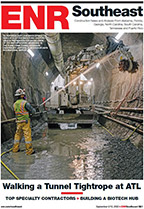Contractors on the centerpiece of San Francisco’s $4.6-billion improvement to the Hetch Hetchy Water System were given notice to proceed on April 1. The five-mile subterranean Bay Division Water Delivery Tunnel planned for under the San Francisco Bay will replace two 1920s and 1930s era pipelines with one 9-ft-dia welded steel pipeline bored as deep as 100 ft under the bay’s floor. The new tunnel will be more secure in an earthquake and a tunnel-boring machine will minimize environmental damage.
A joint venture of Michels Corp., Brownsville, Wis., Jay Dee Contractors, Inc., Livonia, Mich., and Frank Coluccio Construction Co., Seattle, Wash., (MJCJV) won the $215.3-million contract in January. This is the same team that is building the Sound Transit Tunnel in Seattle.
The bidding was competitive, according to SFPUC spokesperson Maureen Barry. Three of the four bidders submitted estimates of under $225 million. The joint venture of Obayashi/Kenny bid $215.4; Traylor/Shea JV bid $224.7 million and Flatiron West bid $245.6 million. Obayashi filed a protest that MJCJV did not meet the Local Business Enterprise subcontracting goals or have the proper qualifications, but the city attorney’s office decided that the protest was without merit.
MJCJV will begin work on the first of two vertical access tunnels in early July and then commence boring a 14-ft dia tunnel using an earth pressure balance tunnel-boring machine. Soil excavated in the dig will be used in a nearby marshland restoration project. The project is planned for completion in 2015.
Jacobs Engineering, San Francisco, Calif., is project managing the dig and two connecting pipeline projects.
Ranger Pipelines, San Francisco, Calif., is laying the $61.5-million 7-mile-long, 60-in.-dia welded steel pipeline from in the East Bay from Fremont to Newark. Mountain Cascade, Inc., Livermore, is building a similar $52.1-million 9-mile pipeline on the Peninsula from Redwood City to East Palo Alto. Both projects came in almost 30% under estimates. The East Bay Reach was $26.4 million under estimates and the Peninsula Reach was $22.1 million less than projected.
The Water System Improvement Project (WSIP), designed to update and make seismic improvements to the water delivery system — which is more than 80 years old — for 2.4 million customers, includes two other tunneling projects.
At the end of March, the joint venture of Shank/Balfour Beatty announced excavation was complete on the $55.7 million, 4,200-ft Crystal Springs Bypass Tunnel.
In May, a contract will be awarded for the $338-million, 3.5-mi, 10.5-ft-dia Irvington Tunnel Project. The shaft will parallel the existing tunnel between the Sunol Valley and Fremont, Calif. This will provide a seismically-designed connection between water supplies from the Sierra Nevada Mountains and the Alameda Watershed to Bay Area water distribution systems.
WSIP encompasses 86 projects and more than 100 miles of pipelines, new water treatment plants and dam improvements.
A $20-million spillway widening and wall raising on the 122-year-old Lower Crystal Springs Dam, a concrete 292-ft tall curved gravity dam in San Mateo County, Calif., could be awarded as early as September. The 1.5-billion-gal expansion will restore operating capacity to 21 billion gal by raising the water level 4 ft with a maximum normal water surface elevation of 287.8 ft. The Calif. Dept. of Water Resources — Division of Safety of Dams lowered the maximum allowable water surface elevation by 8 ft in 1983 to 19.5 billion gal to ensure an adequate buffer in the 22-billion-gal capacity reservoir in case of a probable maximum flood event.
In addition to widening the spillway on the 600-ft crest of the dam, the project includes constructing two bridge piers within the spillway to accommodate rebuilding of a San Mateo County Bridge, removing the existing timber stop-log system, constructing a new weir system within the spillway, installing access cat-walks for operation and maintenance and eliminating water ponding on top of the dam. In addition, crews will raise the parapet wall located on top of the upstream face of the dam and the spillway approach walls by 9 ft for a total of 302 ft.
Timing is very important, said Tasso Mavroudis, SFPUC senior project manager. San Mateo County has to begin demolition of the San Mateo County Bridge in June and be finished by January so the SFPUC can start work on the bridge in February. “The expansion of the stilling basin is the biggest challenge,” Mavroudis said. “It is a very tight deadline for environmental and operational reasons.” If any water spills into the basin before it is complete, the water could undermine the integrity of the dam. Mavroudis said the contractor will have to run multiple shifts to move in excess of 22,000 cu yds of soil, install 11,000 cu yds of concrete and a 10-ft compacted riprap bed between April 15 and November 15.
A planned $256-million replacement for the 210-ft rolled earth and rock fill Calaveras Dam has been held up in the environmental review process. Three contractors have already been pre-qualified: Kiewit Pacific Co., Omaha, Neb.; Granite Construction Inc., Watsonville, Calif.; and Barnard Construction Co. Inc., Bozeman, Mont. Construction on a new engineered center core earth and rock fill dam with a 1,210-ft long crest just downstream of the existing wall is now planned for Spring of 2011. Like Crystal Springs, operating capacity for Calaveras Reservoir was also limited for seismic reasons in the 1980s. The new dam will restore the reservoir to its planned 31,000-acre-ft capacity.






Post a comment to this article
Report Abusive Comment